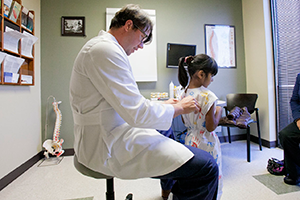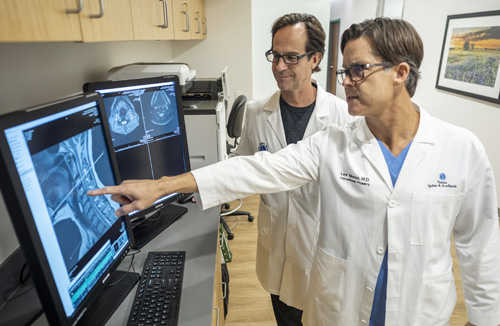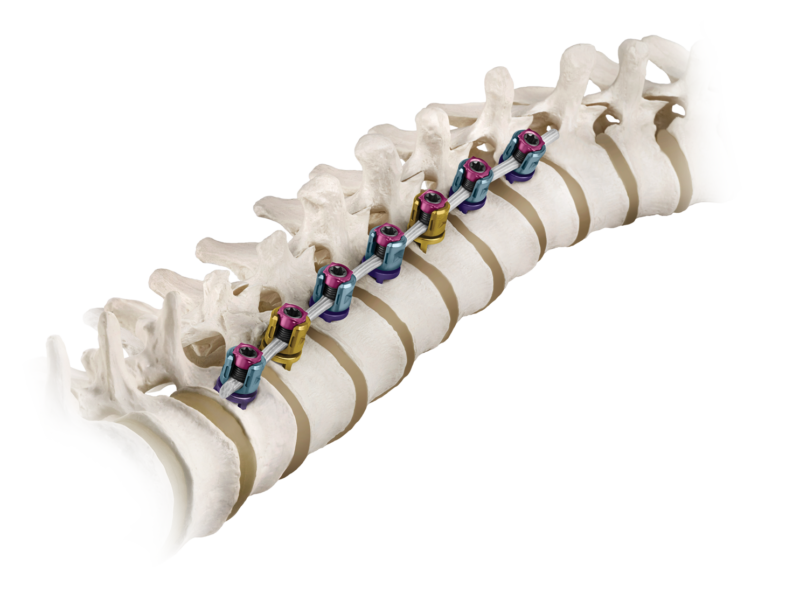
Learn more about the providers at Texas Spine and Scoliosis, the only spine specialized neurosurgery, orthopedic surgery, and non-surgical rehabilitation group in the central Texas area.
The PLIF procedure is a minimally disruptive approach to traditional back surgery. During a PLIF (Posterior Lumbar Interbody Fusion) procedure, the damaged disc is removed from between two vertebrae in the lower back (the lumbar region). The vertebrae are then fused together to reduce motion. The goals of the procedure are to restore stability in the spine, eliminate pain, and treat common spinal pathologies.

Traditionally, a PLIF is performed by making a midline incision in the patient’s back. The attached muscles are then pulled back and laterally (to the side) to allow sufficient exposure for the surgeon to place pedicle screws for fixation. This often results in postoperative approach-related muscle pain and denervation (loss of nerve supply).
The distinct difference between a traditional “open” PLIF and a MIS (minimally invasive surgery) PLIF, is the medialized surgical approach. By using a medialized (closer to the spinous process) screw entry point, the MIS PLIF procedure is designed to eliminate the need to retract muscle laterally past the facet joint to the transverse process, therefore requiring a smaller incision than an “open” PLIF. By minimizing the amount of muscle disruption, this procedure is intended to reduce postoperative approach-related muscle pain and enable a faster recovery for the patient.
In general, the MIS PLIF procedure results in a shorter recovery and a faster return to normal activities compared to a traditional “open” PLIF procedure. Benefits include:
All surgical procedures present risks and complications, and it is important to discuss them with your surgeon prior to surgery. Listening to your surgeon’s guidance, both before and after surgery, will help to encourage the best possible outcome from your procedure.
Operative and postoperative complications known to occur may include: early or late infection which may result in the need for additional surgeries; damage to the spinal cord or peripheral nerves, pulmonary emboli; loss of sensory and/or motor function; permanent pain and/or deformity. Rarely, some complications may be fatal.
| Approach | Full Name | Access Route | Typical Levels Treated | Muscle Disruption | Advantages | Risks/Limitations |
|---|---|---|---|---|---|---|
| TLIF | Transforaminal Lumbar Interbody Fusion | Posterior (from the back, side of spinal canal) | L2 to S1 | Moderate | Good disc space access; unilateral approach reduces nerve retraction | Nerve root injury risk; limited disc space visualization |
| XLIF | Lateral Lumbar Interbody Fusion (eXtreme) | Lateral (through psoas muscle) | T12 to L5 (not L5-S1) | Minimal | Large graft placement; minimal blood loss | Risk to lumbar plexus; not suitable for L5-S1 |
| iLIF | Interlaminar Lumbar Interbody Fusion | Posterior (between spinous processes) | L2 to S1 | Minimal | Preserves stabilizing structures; reduced blood loss | Technically demanding; newer technique, limited long-term data |
| PLIF | Posterior Lumbar Interbody Fusion | Posterior (midline) | L2 to S1 | High | Direct access to disc; bilateral cage placement possible | More muscle disruption; higher blood loss |
| ALIF | Anterior Lumbar Interbody Fusion | Anterior (through abdomen) | L4 to S1 | Minimal (no back muscle disruption) | Wide disc access; large implant size possible | Major vessel injury risk; requires vascular access surgeon |
Texas Spine and Scoliosis is a regional referral center for the treatment of back and neck pain and scoliosis

Learn more about the providers at Texas Spine and Scoliosis, the only spine specialized neurosurgery, orthopedic surgery, and non-surgical rehabilitation group in the central Texas area.
 Texas Spine & Scoliosis approved for the new BRAIVE scoliosis tethering study
Texas Spine & Scoliosis approved for the new BRAIVE scoliosis tethering study

Read about various patient success stories that have been performed by the physicians at Ascension Texas Spine & Scoliosis